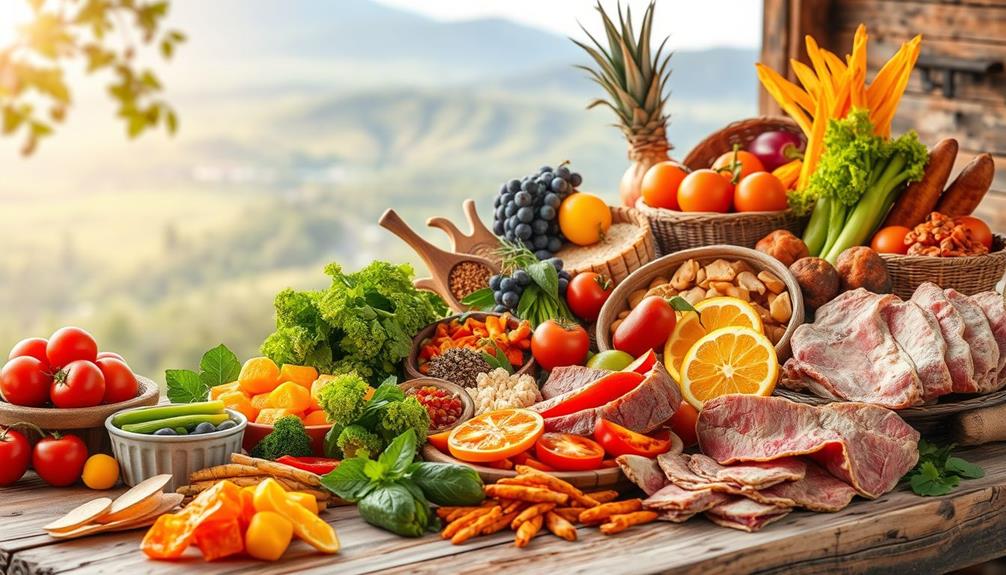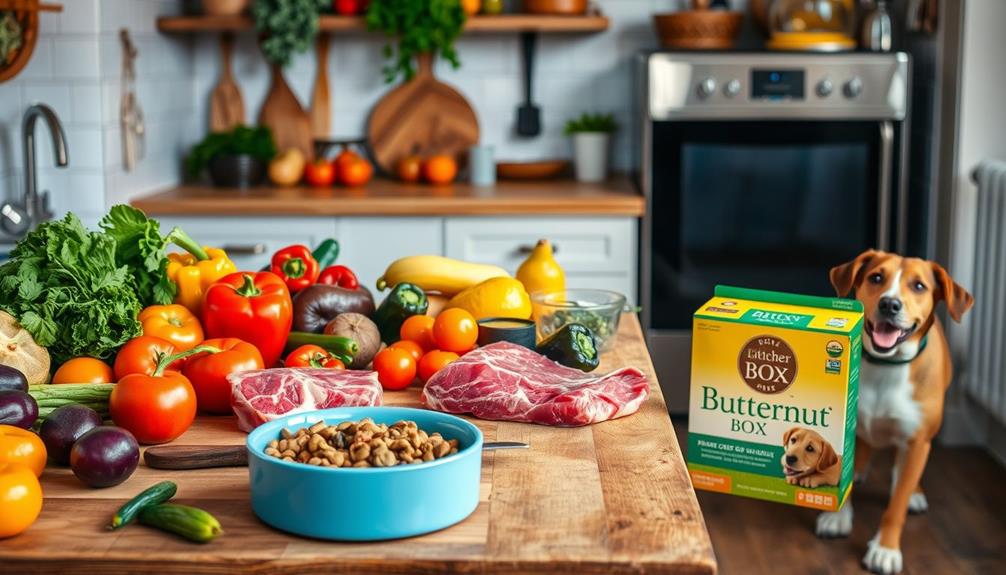To prep raw food for your dog, start by gathering essential tools like a sturdy cutting board, sharp knife, and measuring cups. Choose high-quality meats and balance their diet with muscle meat, organ meat, and veggies. A general guideline is to feed 2-3% of your dog's ideal body weight daily. Prepare meals in advance, using containers to portion out daily servings. Monitor your dog's health and adjust their diet based on their energy levels and life stages. If you want to guarantee your pup gets the best nutrition, there's plenty more essential information available to help you.
Key Takeaways
- Use a sturdy cutting board and sharp knife for safe and clean preparation of raw ingredients.
- Measure and weigh ingredients accurately to ensure balanced nutrition for your dog.
- Store raw food in portioned containers or bags to maintain freshness and streamline feeding.
- Monitor your dog's weight and adjust feeding amounts based on activity level and life stage.
- Regularly evaluate your dog's health to identify any dietary adjustments needed for optimal well-being.
Essential Tools for Preparation
When prepping raw food for your dog, having the right tools makes all the difference. Start with a sturdy cutting board and a sharp knife. These essentials guarantee you can make clean cuts, minimizing contamination risks while working with different meats.
A scale is also vital; it allows you to accurately weigh muscle meat, organ meat, and meaty bones, guaranteeing you meet your dog's specific dietary needs. To keep your pup engaged and satisfied, consider incorporating healthy dog snacks made from natural ingredients into their diet.
To keep your meal prep organized, invest in prep containers. These will help you portion out daily meals, making it easy to grab and serve fresh food when needed. Additionally, measuring cups can streamline the process, especially when portioning ingredients for a balanced diet.
Don't forget about food storage bags, too! They're perfect for freezing any excess raw ingredients, keeping them fresh for future meals.
Calculating Daily Feeding Amounts
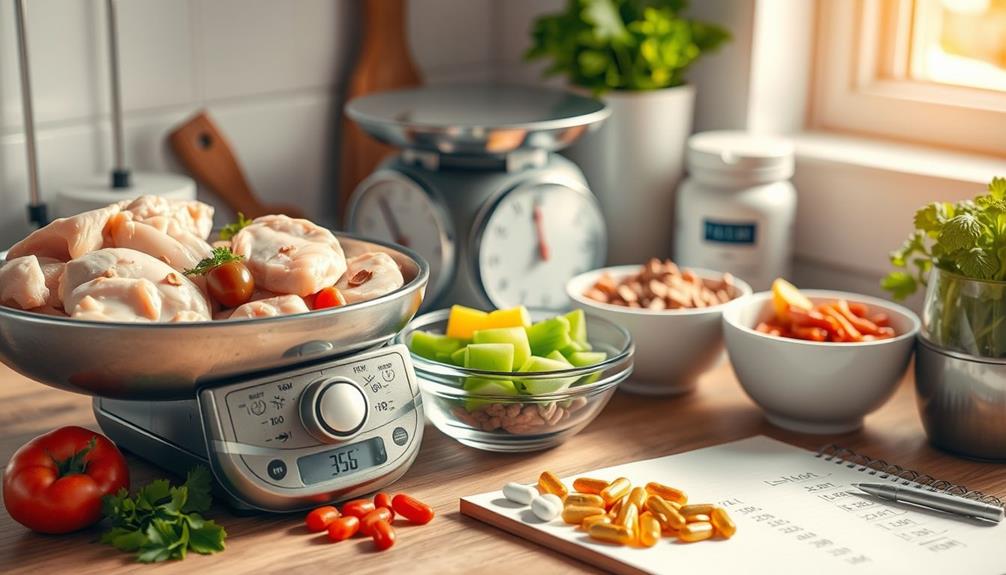
Calculating the right daily feeding amounts for your dog is essential for their health and well-being. A general guideline is to feed 2-3% of their ideal body weight. For example, that's approximately 0.5 lbs for a 25 lb dog and 2 lbs for a 100 lb dog.
Puppies require a higher caloric intake, typically up to 5% of their body weight daily to support their growth. It's important to take into account your dog's overall wellness, similar to how caregivers assess financial considerations for elderly care when planning for their loved ones.
When calculating the amount, take into account the following:
- Assess your dog's activity level and life stage.
- Adjust feeding amounts based on individual needs.
- Use the nutritional value of the food to guide portion sizes.
- Monitor the dog's weight regularly to guarantee they're maintaining an ideal body condition.
- Be prepared to adjust feeding amounts if you notice changes in weight or energy levels.
Weekly and Monthly Estimates
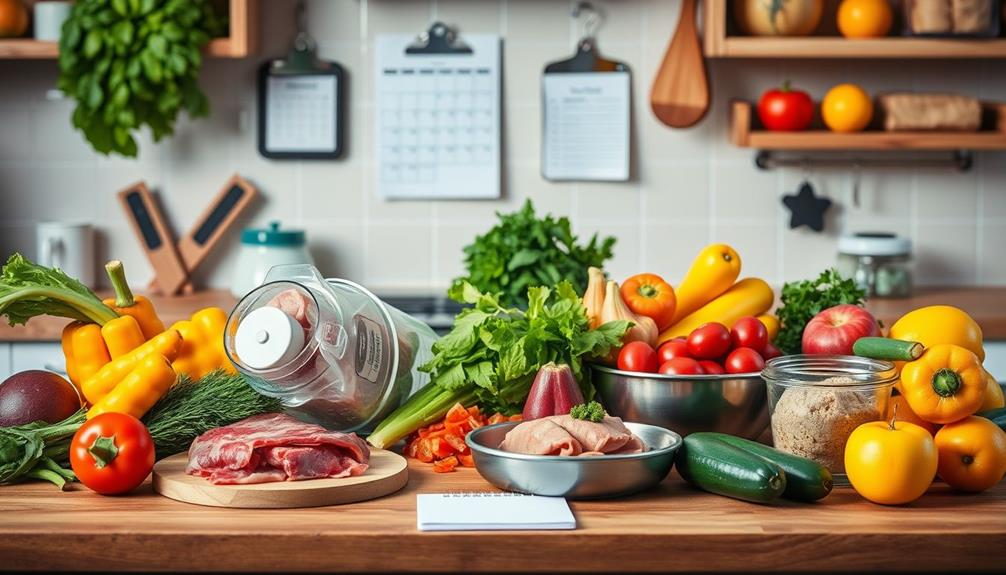
When you're prepping raw food for your dog, it's crucial to have a clear plan for weekly and monthly feeding amounts.
By calculating weekly totals, you can streamline your meal prep and manage your freezer space efficiently.
Additionally, maintaining a budget for your dog's food can help you avoid financial mistakes to avoid while ensuring your pet gets the nutrition they need.
Plus, understanding your monthly budget helps you stay on track with costs while ensuring your pet gets the nutrition they need.
Weekly Feeding Calculations
To guarantee your dog gets the right amount of raw food, you'll want to calculate weekly feeding amounts based on their daily needs.
Start by determining your dog's ideal body weight and their activity level, as this will guide you in estimating the daily food amount, which is typically 2% to 3% of their weight. Additionally, consider how natural remedies alongside conventional medications can support your dog's overall health.
Multiply this daily amount by 7 to get the weekly total.
Here are some steps to simplify your weekly feeding calculations:
- Calculate your dog's ideal body weight.
- Determine the daily raw food amount (2-3% of their weight).
- Multiply the daily amount by 7 for a weekly total.
- Adjust based on your dog's activity level or specific dietary needs.
- Use this weekly total to streamline your meal prep and shopping.
Monthly Budgeting Tips
Establishing a monthly budget for your dog's raw food is essential for maintaining financial control while guaranteeing they receive the nutrition they need. Start by calculating your weekly feeding totals; simply multiply these by 4 for a 28-day estimate or by 30 for a 30-day estimate. This gives you a clearer picture of your expenses for the month.
Since the average cost of a raw diet in the US is about $2.50 per pound, knowing your dog's total monthly food requirement can help keep costs in check. Additionally, incorporating a variety of fruits and vegetables can enhance your dog's diet, similar to strategies for lifestyle for longevity in humans.
To simplify meal prep, multiply your daily feeding amounts by 7 to guarantee you have enough ingredient quantities on hand for each week. As you plan, remember to adjust feeding amounts based on your dog's individual needs, such as their activity level or life stage, so you don't overspend on unnecessary food.
Additionally, keep track of expenses and ingredient quantities while meal prepping. This habit will help you streamline your budget and make adjustments as needed to stay on target with your financial goals.
Meal Planning Strategies
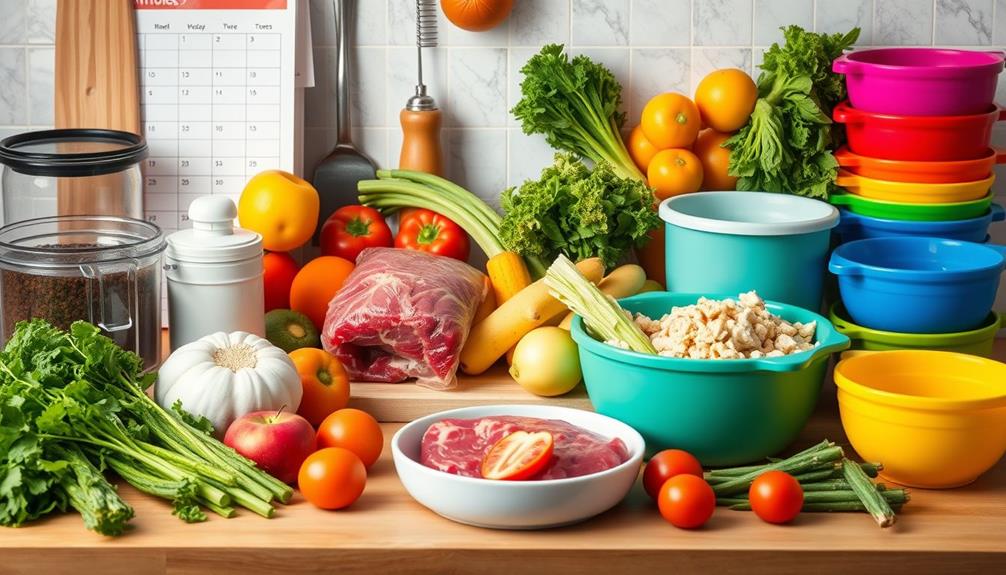
Planning your dog's meals efficiently can save you time and guarantee your furry friend gets the nutrition they need. Implementing effective meal planning strategies is key to successfully feeding dogs raw.
Start by setting up a dedicated meal prep station to streamline your process, and consider incorporating essential oils for pet wellness to enhance your dog's overall health. Here are some tips to keep in mind:
- Choose a few balanced diet recipes to begin with—aim for 3-4 meals per week.
- Store raw ingredients in 5-7 day increments for peak freshness.
- Calculate the amount needed by multiplying daily feeding amounts by 7 for weekly totals.
- Assemble one meal per pet daily to guarantee you're providing the nutrients dogs need.
- Regularly evaluate your meal prep effectiveness and adapt as your dog's needs change.
As you grow more comfortable with meal prepping, you can gradually introduce new recipes.
Ingredient Selection Guidelines
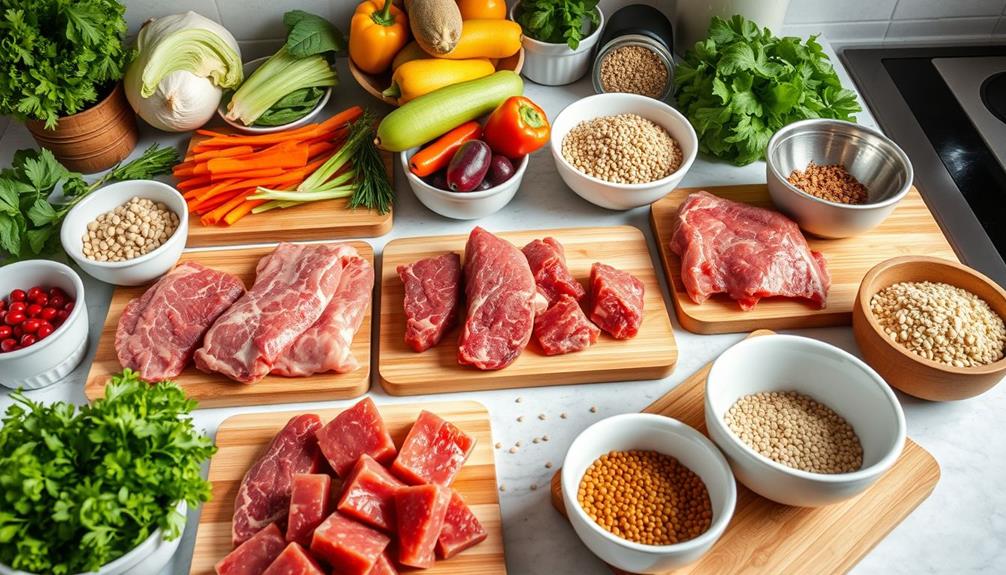
How can you guarantee your dog gets the best nutrition possible? Start with ingredient selection. Focus on high-quality meats from reputable sources, opting for fresh, whole foods and avoiding processed options to maintain nutritional integrity.
Incorporate a variety of protein sources, including muscle meats and organ meats like liver (10% of the diet) and heart (5%), to create a balanced nutrition profile. Additionally, consider the importance of regular health checks for your dog, as this can help identify any dietary needs or adjustments needed over time, akin to routine health checks for pets.
Don't forget to add fruits and vegetables, making up about 10% of the diet. Organic choices like broccoli, kale, and blueberries are excellent, offering antioxidants and anti-inflammatory benefits.
When introducing organ meats, do so gradually to prevent digestive upset, aiming for a total of 5%-10% of the diet.
Lastly, it's essential to monitor reactions to different protein sources. This way, you can identify any potential allergies or sensitivities your dog may have, ensuring a well-rounded and personalized dietary approach.
Nutritional Balance Considerations
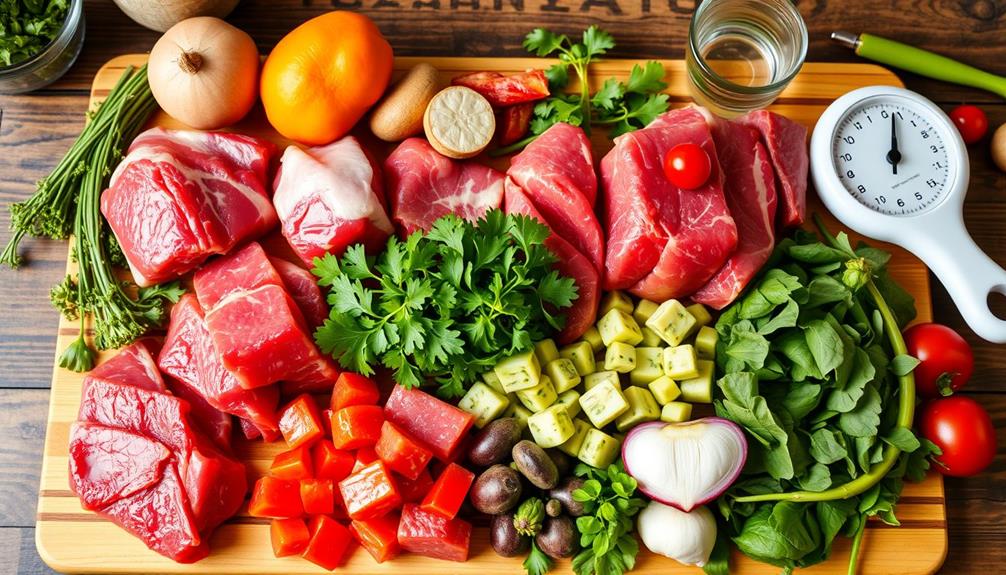
A well-balanced raw food diet for your dog is essential for their overall health and vigor. To achieve this balance, you should aim for a diet that consists of approximately 70% meat, 10% bone, and 10% organ meats, with the remaining 10% dedicated to fruits and vegetables. This mix guarantees a variety of essential nutrients. Including antioxidant-rich foods can further support your dog's immune system and overall well-being.
Here are key points to take into account for nutritional balance:
- Protein and Fat: Confirm protein makes up a significant portion of the diet, while fat should be around 10%-20% for energy.
- Organ Meats: Incorporate organ meats like liver and heart, which are rich in vitamins and minerals.
- Variety of Meats: Rotate protein sources to avoid dietary monotony and provide a broader nutrient profile.
- Bone Inclusion: Include bones at 10% to 15% of the diet, especially for puppies who need more for growth.
- Fruits and Vegetables: Don't forget the importance of incorporating fruits and veggies to boost nutrient diversity.
Bone Management Techniques

When choosing bones for your dog, pick ones that match their size to avoid choking hazards.
It's also beneficial to select bones that are low in fat and rich in nutrients, as this can contribute to your dog's overall health and well-being.
Always monitor your pup while they're enjoying their bones, and consider rotating different types to keep things interesting.
Understanding bone content in their diet is key to ensuring they get the right nutrients without risking injury.
For more insights on maintaining a clean environment while preparing raw food, refer to best vacuums for dust removal.
Selecting Appropriate Bones
Selecting the right bones for your dog is crucial for their safety and health. To guarantee a balanced and safe raw diet, you'll want to take into account several factors when selecting bones. For instance, bones that are too small can pose a choking hazard, while those that are too hard might damage your dog's teeth.
Additionally, be mindful of the healing process of your dog's digestive system, as certain bones can aid in piercing care and hygiene through their natural enzymes. Here are some essential tips:
- Choose bones appropriate for your dog's size to avoid choking hazards.
- Opt for meaty bones, which are nutrient-dense and packed with essential minerals.
- Avoid cooked bones, as they can splinter and cause serious injuries.
- Monitor your dog while they chew bones to prevent choking.
- Rotate different types of bones to maintain dietary variety and keep mealtime interesting.
Maintaining a bone content of 10%-15% in your dog's diet is ideal, while puppies need at least 12% to support their growth. For example, chicken necks, which contain about 36% bone, can contribute greatly to this balance; when feeding half a meal of chicken necks, you're providing around 18% bone content.
Adjust this based on your dog's specific dietary needs and size. By carefully selecting bones, you help guarantee your furry friend enjoys a safe, healthy, and satisfying raw diet.
Monitoring Bone Consumption
Regularly monitoring your dog's bone consumption is vital to confirm their safety and health while enjoying a raw diet. To maintain a balanced raw diet, aim for 10% to 15% of your dog's diet to consist of bones. For puppies, ascertain at least 12% bone content to support their growth.
Always choose meaty bones appropriate for your dog's size to prevent choking and intestinal blockages. When feeding a raw diet, pay attention to the type and amount of calories in the bones. For example, chicken necks contain 36% bone, so if you use them as half a meal, you're providing 18% bone content.
It's important to calculate the percentage of bone accurately to meet your target ratio for a balanced diet. While your dog enjoys their bones, monitor them closely to prevent choking. Rotate the types of bones you offer to avoid dietary monotony and confirm a variety of nutrients.
This not only promotes healthy chewing and dental health but also keeps your dog engaged. By following these monitoring bone consumption techniques, you'll support your dog's well-being and enhance their raw feeding experience.
Health Monitoring Practices
Monitoring your dog's health is vital for guaranteeing that their raw food diet meets their nutritional needs. As a pet parent, you'll want to keep a close eye on various factors that indicate your dog's health status and dietary effectiveness.
Regular vet check-ups are essential for evaluating your dog's overall health and making necessary adjustments to their raw diet.
Here are some key health monitoring practices to adopt:
- Monitor your dog's coat and skin for any changes; a dull coat may indicate nutritional deficiencies.
- Track your dog's energy levels to confirm they're meeting their energy requirements; low energy could signal an imbalance.
- Keep a food diary to note your dog's reactions to different ingredients, helping you spot allergies or sensitivities.
- Observe stool consistency and frequency; firmer, smaller stools usually indicate better digestion.
- Maintain a consistent schedule for health evaluations to make sure dietary changes align with your dog's growth and activity level.
Adjusting Diet for Life Stages
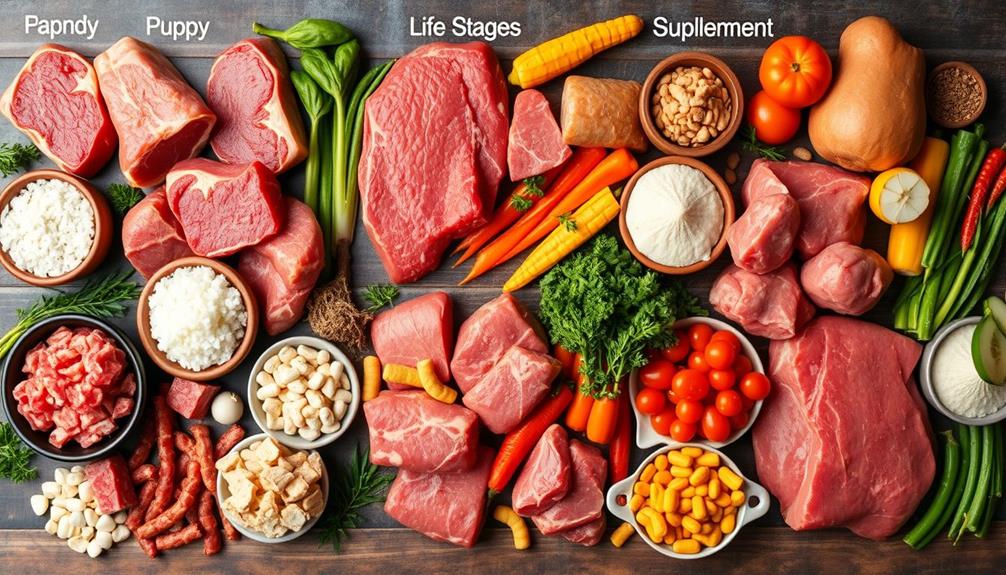
As your dog moves through different life stages, adjusting their raw food diet becomes essential to meet their evolving nutritional needs.
Puppies require a higher caloric intake, typically 5-10% of their body weight daily, to fuel their rapid growth. In contrast, adult dogs generally need only 2-3%. It's important to modify the fat content of their diet accordingly; puppies need 10-20% fat for growth, while senior dogs should have less to prevent obesity.
For senior dogs, focus on high-quality protein and fiber to aid digestion, as their activity levels and metabolism slow down.
Organ meats should comprise 10-15% of the diet for adult dogs, but puppies may need slightly more to guarantee they receive essential nutrients like vitamins and minerals.
Regularly monitor your dog's health, coat condition, and energy levels to determine if further adjustments are necessary.
Frequently Asked Questions
How to Prep a Raw Food Diet for Dogs?
To prep a raw food diet for your dog, choose high-quality meats, weigh portions accurately, store ingredients properly, and gradually shift over 7-10 days, adding necessary nutrients for a balanced, nutritious meal plan. If you’re unsure about how to start a raw food diet for your dog, consult with a veterinarian or a pet nutritionist for guidance. They can provide personalized recommendations based on your dog’s age, breed, and any existing health conditions. Additionally, there are many resources available online and in books that can provide helpful tips and recipes for transitioning your dog to a raw food diet. Researching how to start a raw food diet can help ensure that your dog is getting the proper balance of nutrients and is thriving on their new diet.
How Do You Raw Feed a Dog for Beginners?
Starting your raw feeding journey's like stepping into a time machine! You'll gradually shift your dog, measure food accurately, and choose high-quality meats. Remember to practice safe handling and store food properly for freshness!
How to Properly Handle Raw Dog Food?
To properly handle raw dog food, always wash your hands and surfaces after contact. Use separate utensils, store food in the freezer, and regularly clean feeding areas to prevent contamination and keep your dog safe.
What Can I Add to Raw Dog Food to Make It Complete?
To make your raw dog food complete, add muscle meat, organ meat, and bones, along with fruits and veggies. Don't forget to include essential oils and additional nutrients for a balanced, healthy diet!
Conclusion
In the world of raw feeding, you're the maestro, conducting a symphony of nutrition for your furry friend. With the right tools and a sprinkle of planning, you'll create meals that dance with flavors and nutrients. Remember, as your dog grows, their needs shift like the changing seasons, so stay attuned to their health and happiness. By embracing these crucial tips, you're not just feeding; you're nurturing a vibrant life filled with joy and energy.




